
08 Jun Ones to Watch: Artist Jinni Thomas
Jinni Thomas doesn’t see things, she feels them. Her works, delicate storied pieces, delve and dip, revealing themselves in scratches and scrapes. They pull back the ribs and expose a small, still-beating heart.
“If I had thought my career over again, I wish I’d gone into restoration,” Thomas says. “That’s sort of where my work is right now. I feel like I’m restoring my life or my tapestry.”
Although her paintings infer the richness of weaving, her paintings do not reference textiles. They bypass the metaphor and get right into the humanity of the piece. “I put a lot of paint on and take a lot of paint off, as well as other materials, like plaster and charcoal,” she says. “Then I dig through it with sanding and solvents to bring up previous textures and color, going through different paint layers.”
This is especially keen when the piece is thick with paint and plaster. “What I’ve written or drawn in shows up as textures,” she says. “I’m creating my own kind of beauty on the canvas.”
A continuing theme for Thomas is the rose. She draws them in her under paintings, a circular rhythm pounding below the surface, invisible except for a lingering bloom. She writes, “renaissance rose” in charcoal over and over, not to be read but as marks on the canvas.
“In studying art history, the white rose symbolized the Madonna and her purity, and the red rose was the blood of Christ; it’s a symbol of love, a symbol of beauty, a symbol for eternal life, and I do have a love of flowers from my mother’s garden,” Thomas says. “It’s a perfect flower for me and it opens into many layers, like my paintings are many layers.”
Not only do they play a role in her paintings, but she also creates roses from paper. The roses are placed in squares, like a deep bass relief. “When I began making more 3-D work, I took silk ribbon and started making roses,” she says. “I made them into a more contemporary form. Using the classic repetition pattern — the simple square, which is a perfect form — I hand – sewed the roses in several different colors. Then I started making them out of newspaper.”
She goes through newspapers to find full-color inked paper. This was something spurred by 9/11. “I used The New York Times and The Wall Street Journal — the first ones I did had photos of the victims of 9/11,” she says. “I call them all Tribute Rose. There’s no color added. I wind the newspaper like the silk and then I dip them into hot beeswax. I’ve made walls of them, but now I only do these 12-inch-by-12-inch pieces.”
Her work has been shown at the Albuquerque Museum in New Mexico and the El Paso Museum in Texas. She has done commission work for the Wynn resort in Macao, China, and several for MD Anderson in Houston, Texas. She is represented by the Karan Ruhlen Gallery in Santa Fe, New Mexico.
- “Antiquities I and II” | Mixed Media, Gold Leaf on Panel | 48 x 30 inches each (diptych) | 2015
- “Restoration of a Tapestry IV” | Mixed Media on Panel | 64 x 48 inches | 2014
- Artist Jinni Thomas









No Comments